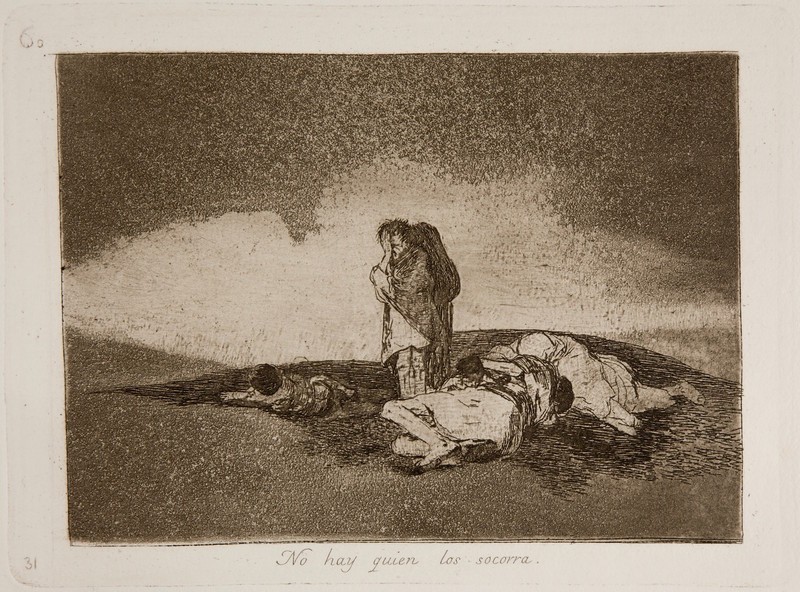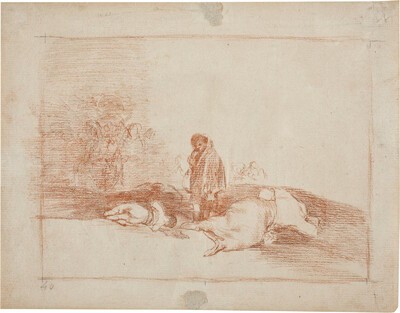- Cronología
- Ca. 1812 - 1815
- Dimensiones
- 154 x 207 mm
- Técnica y soporte
- Aguafuerte, aguatinta bruñida, buril y bruñidor
- Reconocimiento de la autoría de Goya
- Undisputed work
- Ficha: realización/revisión
- 03 Feb 2013 / 24 May 2023
- Inventario
- 225
31 (on the lower left-hand corner).
See Sad presentiments of what must come to pass.
The title was handwritten on the print by Goya in the first and only series that is known to have been printed at the time the works were created, which the artist gave to his friend Agustín Ceán Bermúdez. Therefore, the title was etched into the plate at a later date and left unchanged as of the first edition of the Disasters of War printed by the San Fernando Royal Academy of Fine Arts in Madrid in 1863, after the printing of the series in the possession of Ceán Bermúdez.
There is a surviving preparatory drawing for this print which is housed in the Prado Museum in Madrid.
In the middle of a waste ground a man stands with his hand over his face in a gesture of desperation. He is surrounded by the corpses of victims of the famine that devastated Spain during the Spanish War of Independence.
Goya renders a very dark, granular sky in the upper part of the composition in aquatint, while the central part of the plate has been left clear. The use of this device gives the effect of an omen of death looming over the central standing figure and highlights his presence in the print. The corpses are rendered in aquatint: two of them are wearing white clothing that captures the attention of the viewer. The painter depicts the ragged, oversized clothing and emaciated, bony limbs of the wasted figure who covers his face in great detail.
There is no one to help them can be linked to print no. 18, Bury them and keep quiet (Enterrar y callar) of this series, in which Goya represents a survivor of the famine surrounded by corpses in a desolate landscape. In the case of both prints the only living figure seems aware that he also is condemned to die.
The print also alludes to the government's inability to deal with the famine that decimated the population. On 19 November 1811 Joseph Bonaparte (Corte, 1768 - Florence, 1844) issued a decree establishing the "Establecimiento de Beneficencia", which was subsequently replaced on 7 September 1812 by the "Junta de Caridad", both of which were charitable institutions whose purpose was to supply low-cost food to the citizens of Madrid. To this end, the Establecimiento de Beneficencia was provided with 50,000 reales to cover its costs. However, some months later the local authorities in Madrid sent a report to describing the King detailing the institution's precarious situation. The hospitals and sanatoriums provided shelter for more than 8,000 people, and the resources available to them were insufficient to the task of preventing starvation in the population.
The plate is stored in the National Chalcography (cat. 311).
-
De grafiek van GoyaRijksmuseum RijksprentenkabinetAmsterdam1970from November 13th 1970 to January 17th 1971cat. 82
-
Goya y el espíritu de la IlustraciónMuseo Nacional del PradoMadrid1988from October 6th to December 18th 1988. Exhibited also at Museum of Fine Arts, Boston, January 18th to March 26th 1989; The Metropolitan Museum of Art, Nueva York, May 9th to July 16th 1989, Madrid curator Manuela B. Mena Marqués, scientific directors Alfonso E. Pérez Sánchez and Eleanor A. Sayrecat. 93
-
Francisco Goya. Sein leben im spiegel der graphik. Fuendetodos 1746-1828 Bordeaux. 1746-1996Galerie KornfeldBern1996from November 21st 1996 to January 1997cat. 144
-
Francisco de GoyaMuseo d'Arte ModernaLugano1996exhibition celebrated from September 22nd to November 17th.cat. 60
-
Das Capriccio als KunstprinzipWallraf-Richartz-Museum,1996from December 8th 1996 to February 16th 1997, exhibited also in Zurich, Kunsthaus, from March 14th marzo 1997 to June 1st 1997 and in Vienna, Kunsthistorisches Museum mi Palais Harrach, from June 29th 1997 to September 21st 1997.cat. 110
-
Francisco Goya. Capricci, follie e disastri della guerraSan Donato Milanese2000Opere grafiche della Fondazione Antonio Mazzottacat. 140
-
Goya et la modernitéPinacothèque de ParisParís2013from October 11st 2013 to March 16th 2014cat. 99
-
2022
-
Goya, grabadorBibliography']['numberMadridBlass S.A.1918cat. 162
-
Goya engravings and lithographs, vol. I y II.Bibliography']['numberOxfordBruno Cassirer1964cat. 180
-
Vie et ouvre de Francisco de GoyaBibliography']['numberParísOffice du livre1970cat. 1094
-
Goya y el espíritu de la IlustraciónBibliography']['numberMadridMuseo del Prado1988pp. 314-315, cat. 93
-
Catálogo de las estampas de Goya en la Biblioteca NacionalBibliography']['numberMadridMinisterio de Educación y Cultura, Biblioteca Nacional1996cat. 274
-
Bibliography']['number
ParísPinacoteca de París2013p. 149
-
Goya. In the Norton Simon MuseumBibliography']['numberPasadenaNorton Simon Museum2016pp. 114-151
-
Bibliography']['number
Museo de Bellas Artes de Badajoz y Diputación de Badajoz2022p. 80

